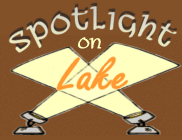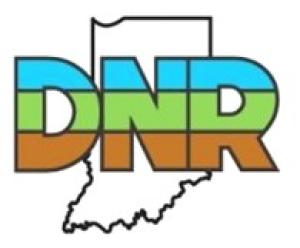
Indiana’s Deer Reduction Zone is open
Deer Reduction Zones provide hunters with opportunities to harvest deer in defined urban areas and along portions of Indiana highways, in addition to statewide bag limits. You can view the reduction zone boundaries for your area on our deer webpage.
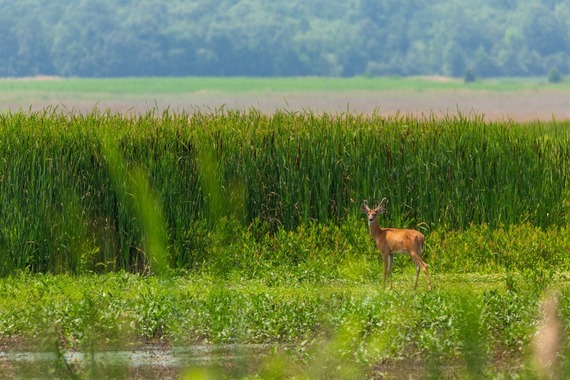
Note: This year, after collecting data to map and evaluate the effects of EHD, DNR lowered the 2023 County Bonus Antlerless Quota (CBAQ) to zero for Fayette and Franklin counties (down from the normal CBAQ of three) to lower the harvest during the next one-to-two years in this area.
If you’ve seen sick or dead deer, report them through our Sick and Dead Wildlife Report Form. Your reports are sent directly to an Indiana DNR biologist who evaluates the reports and uses them to monitor wildlife health over time, detect disease outbreak events, and identify areas for disease surveillance.

Fall turkey: A target for everyone
Oct. 1 marked the start of turkey archery season, and we want you to know the best strategies for a successful hunt.
- Imitate turkey clucks and foraging sounds. Because wild turkeys are focused on foraging in the fall, you can bring flocks to you by imitating calls and scratching (foraging) sounds. These sounds will make the resident turkeys think a new bird is in their territory, and they may bring their whole flock toward you to investigate.
- Keep track of where you see turkeys feeding. In early fall, turkeys feed on insects, so look for fields with a lot of bug activity. Toward the later part of the season, they will switch to eating mast, the fruits produced by trees. It can be hard to find their feeding grounds, but turkeys frequently stay in the same area day after day. This means that if you see them in a field one day, they’ll likely return to the same field the next day.
If you’re a deer archery hunter, consider grabbing a turkey tag with your usual deer license. According to 2020’s Archer’s Index observations, on average, you are likely to see a turkey every three hours while in the field, with the highest probabilities in the northwest part of the state.
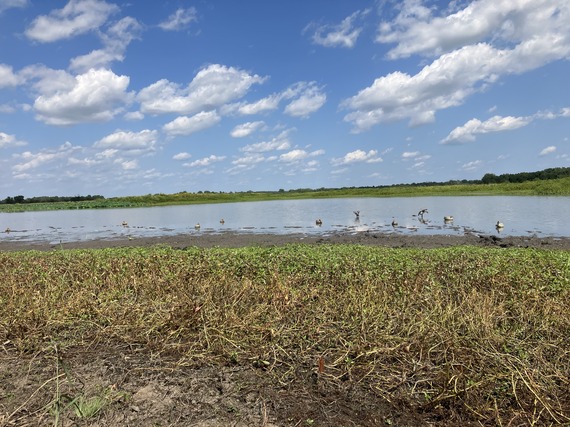
2023-24 Early migratory bird hunting seasons
If you haven’t been bird hunting yet, it’s not too late. Several migratory bird hunting seasons open in October. Check out our migratory bird season dates below to plan your upcoming hunting trips.
Ducks and coots:
- North Zone: Oct. 28 – Dec. 17, Dec. 26 – Jan. 3
- Central Zone: Nov. 4 – Nov. 12, Nov. 24 – Jan. 13
- South Zone: Nov. 11 – 12, Dec. 2 – Jan. 28
Geese:
- North Zone: Oct. 28 – Nov. 5, Nov. 18 – Feb. 11
- Central Zone: Nov. 4 – 18, Nov. 24 – Feb. 11
- South Zone: Nov. 11 – Feb. 11
For more information on full season dates and bag limits, visit our website on migratory bird regulations.

2023 Youth and Veteran waterfowl hunting seasons
Since 2019, DNR has held special dates for youth and veterans to hunt waterfowl in Indiana. If you’re interested in joining one of our 2023 hunt weekends, visit your favorite duck hunting spot on some of the dates listed below:
- North Zone: Oct. 21 – 22
- Central Zone: Oct. 28 – 29
- South Zone: Nov. 4 – 5
Hunting is for everyone. Have questions about accessibility at our Fish & Wildlife areas? Contact a property to find out more information. Indiana residents who have served in the armed forces and have a documented, service-connected disability are eligible for a DAV license. We hope to see you by the water soon.

Got a TIP? Report a poacher or polluter
Do you have any TIPs for Indiana DNR? Turn in a Poacher (TIP) protects our fish and wildlife resources by increasing public support and involvement in bringing violators to justice.
Whether you’re fishing, hunting or taking a hike, DNR welcomes you to submit your information to TIP. If you have evidence of a poacher or polluter, you can report potential violations by calling 1-800-TIP-IDNR (800-847-4367). If your information leads to an arrest, you may receive as much as a $500 reward, and you can choose to remain anonymous.
You can also TIP by using our online form.
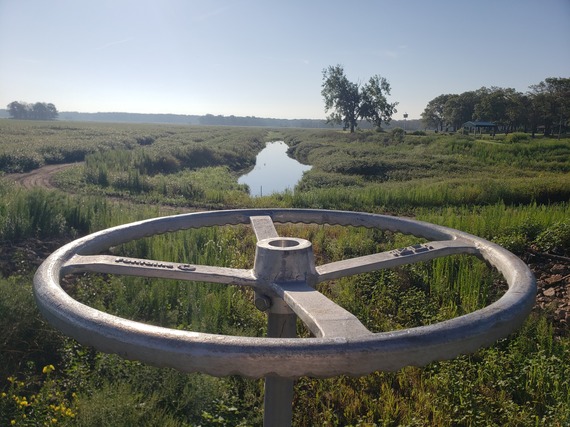
J.C. Murphey Lake renovation update: The final steps
Since 2022, J.C. Murphey Lake at Willow Slough Fish & Wildlife Area has been undergoing extensive renovations. Last year, its sport fish were salvaged, and the lake was drained. Efforts such as cleaning ditches, creating islands, and installing habitat followed.
The 1,000-acre lake is currently being refilled. Due to drought conditions, that process has been slow. The lake will intentionally be kept below full pool during 2024 to improve habitat; however, along with the first of many sport fish stockings this fall, renovations are nearing completion.
With its enhancements, the lake will provide even better opportunities for hunting and trapping for Hoosiers.

Learn about lead: What species does lead exposure effect?
Bald eagles aren’t the only species affected by lead exposure in the environment. Many raptor species, including song sparrows, loons, vultures, mourning doves, peregrine falcons, and more can be negatively affected by lead exposure. Species like mussels and turtles depend on clean water to survive, so higher levels of lead in their water effects their health, too.
Looking for ways to help reduce lead exposure in the environment? Check out our webpage to find out what you can do to minimize lead exposure in outdoor recreation.
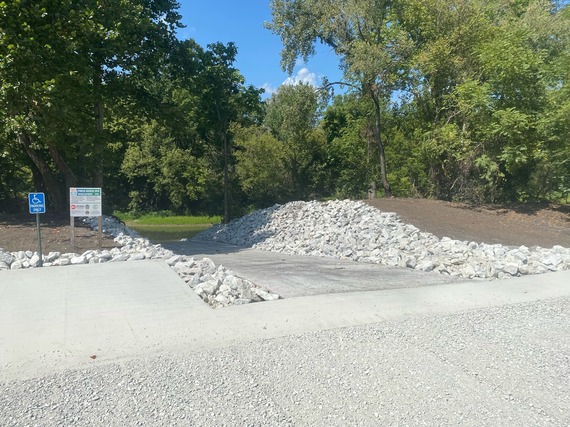
Cart your kayak to Carthage! A new public access site awaits
A new public access site for the Big Blue River near Carthage in Rush County is finished and ready for public use. Thank you to the Carthage Fire Department, which made development of this site possible. With a paved ADA parking space and an attached walkway stretching to the top of the boat ramp, this site offers a great takeout location for kayaks and canoes downriver from the Knightstown Public Access Site (coordinates 39.784971, -85.526859).
The coordinates of the Carthage site are 39.73597,-85.576259. Enjoy a fall day on the water at these public access sites or at one of the more than 400 others around the state.
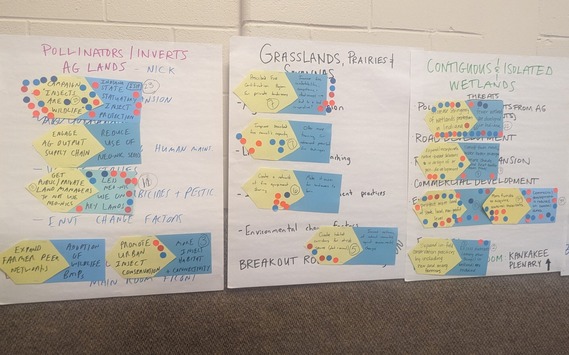
Going north: The Indiana State Wildlife Action Plan’s latest workshop focus
Collaborative conservation planning includes brainstorming sessions, scribbled posters, and voting with sticky dots, as shown above. The revision process for the 2025 Indiana State Wildlife Action Plan (SWAP) spent last month focused on the northern part of the state. Every 10 years, the SWAP is revised to develop priorities and action steps for Indiana conservation. Our new revision process focuses on inviting local partners to co-create a regional plan for the six regions of the state. In this revision, we are focusing on whole system conservation: plants, wildlife, fish, and people! Thank you to our partners who attended.
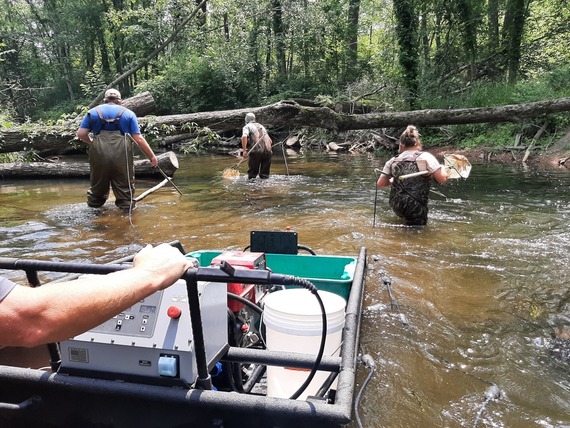
Brown Trout Survey on Little Elkhart and Pigeon rivers
In July, biologists from northern Indiana spent several days surveying brown trout in the Little Elkhart River in Elkhart County and the Pigeon River in Steuben County. The surveys will help biologists monitor the status of the trout fisheries and provide valuable information on survival and size structure of the population.
In addition to monitoring the survival of our stocked trout, DNR is now raising our own brown trout at Curtis Creek Trout Rearing Station. To find out more information on current trout stockings, see our fish stocking webpage.
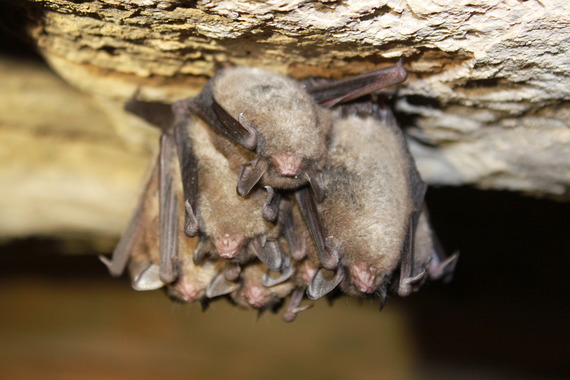
The best week for bats: October’s Bat Week celebration
Bat Week’s annual celebration to recognize bat conservation is Oct. 24 – 31. The event honors the vital role bats play in keeping our natural resources and lands healthy. (We’re especially grateful for the Indiana bat.) Visit Bat Week’s website to build your own bat box, learn more about bat diseases like white nose syndrome, and find tools for becoming a bat advocate in your area.
To learn more about bats in Indiana, watch our "Become a Bat Master!" Webinar on YouTube.
Recent news releases
DNR conserves new public prairie land and wetland in Noble County
Celebrate National Public Lands Day with DNR, Sept. 23, 24
Put and Take pheasant hunt registration opens Sept. 13
Upcoming events
- Oct. 8 – The Big Sit & Wild Game Lunch, Goose Pond FWA
- Oct. 11 – Project WET Educator Workshop, Ellis Park, Danville
- Oct. 14 – Fur School: Trapping 101, Goose Pond FWA
- 2024: April 8 – Total Solar Eclipse, State of Indiana
More
- Buy a license
- Hunting information
- Where to Hunt
- Fishing information
- Where to Fish
- Fish & Wildlife properties

The Indiana Natural Resources Foundation celebrates and preserves Indiana’s natural legacy by raising funds to support the Indiana Department of Natural Resources (DNR) and its programs. Together, we have helped expand public lands, restore wildlife habitat, and create outdoor educational and recreational opportunities for Hoosiers.
About Fish and Wildlife Management in Indiana
Fish and wildlife management and public access are funded by fishing and hunting license revenue and also through the Wildlife and Sport Fish Restoration Programs administered by the U.S. Fish & Wildlife Service. These programs collect excise taxes on sporting arms and ammunition, archery equipment, fishing equipment, and motor boat fuels. The money is distributed among state fish and wildlife agencies based on land size and the number of licensed anglers and hunters in each state. Find out more information about fish and wildlife management in Indiana at Wildlife.IN.gov.
